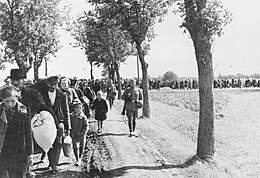
Back درانغ ناخ أوستين Arabic Натиск на изток Bulgarian Expansió cap a l'Est Catalan Drang nach Osten Czech Drang nach Osten Danish Drang nach Osten German Drang nach Osten Spanish Drang nach Osten Estonian Drang nach Osten Basque درانگ ناخ استن Persian

Drang nach Osten (German: [ˈdʁaŋ nax ˈʔɔstn̩]; 'Drive to the East',[1][2] or 'push eastward',[3] 'desire to push east'[4]) was the name for a 19th-century German nationalist intent to expand Germany into Slavic territories of Central and Eastern Europe.[2][5] In some historical discourse, Drang nach Osten combines historical German settlement in Central and Eastern Europe, medieval (12th to 13th century)[6] military expeditions such as those of the Teutonic Knights (the Northern Crusades), and Germanisation policies and warfare of modern German states such as those that implemented Nazism's concept of Lebensraum.[3][7]
In Polish works the term Drang nach Osten could refer to programs for the Germanization of Poland,[8] while in 19th-century Germany the slogan was used variously of a wider nationalist approbation of medieval German settlement in the east and the idea of the "superiority of German culture".[1] In the years after World War I the idea of a Drang nach Westen ('drive to the west'), an alleged Polish drive westward—an analogy of Drang nach Osten—circulated among German authors in reaction to the loss of eastern territories and the Polish Corridor.[1][9]
The concept of Drang nach Osten became a core element of Nazi ideology. In Mein Kampf (1925–1926), Adolf Hitler declares the idea to be an essential element of his reorganisation plans for Europe. He states: "It is eastwards, only and always eastwards, that the veins of our race must expand. It is the direction which nature herself has decreed for the expansion of the German peoples."[10]
- ^ a b c Ulrich Best, Transgression as a Rule: German–Polish cross-border cooperation, border discourse and EU-enlargement, 2008, p. 58, ISBN 978-3825806545
- ^ a b Edmund Jan Osmańczyk, Anthony Mango, Encyclopedia of the United Nations and International Agreements, 2003, p. 579, ISBN 978-0415939218
- ^ a b Jerzy Jan Lerski, Piotr Wróbel, Richard J. Kozicki, Historical Dictionary of Poland, 966–1945, 1996, p. 118, ISBN 978-0313260070
- ^ Marcin Zaborowski, Germany, Poland and Europe, p. 32
- ^ W. Wippermann, Der "deutsche Drang nach Osten": Ideologie und Wirklichkeit eines politischen Schlagwortes, Wissenschaftliche Buchgesellschaft, 1981, p. 87
- ^ Drang nach Osten in the Encyclopædia Britannica
- ^ Ingo Haar, Historiker im Nationalsozialismus, p. 17.
- ^
Best, Ulrich (2007). "III.2.3. The moving Other: the 'Drang nach Osten'". Transgression as a Rule: German-Polish Cross-border Cooperation, Border Discourse and EU-enlargement. Volume 3 of Forum Politische Geographie. Berlin: LIT Verlag. p. 58. ISBN 978-3825806545. Retrieved 10 December 2022.
In 1896, a Polish encyclopedia defined 'Drang nach Osten': 'the drive of the Germans eastward to de-nationalise the Polish people' [...]. [...] In Poland, the slogan ties in with nationalist discourse that put the Polish nation in the role of a suffering nation, in particular at the hands of the German enemy. [...] It also responded to the situation in the Prussian-administered part of Poland, where in the later part of the 19th century Bismarck's policy of Germanisation was applied.
- ^ Bascom Barry Hayes, Bismarck and Mitteleuropa, 1994, p. 17, ISBN 978-0838635124
- ^ Hitler, a chronology of his life and time. Milan Hauner, Macmillan, 1983, p. 197.
© MMXXIII Rich X Search. We shall prevail. All rights reserved. Rich X Search